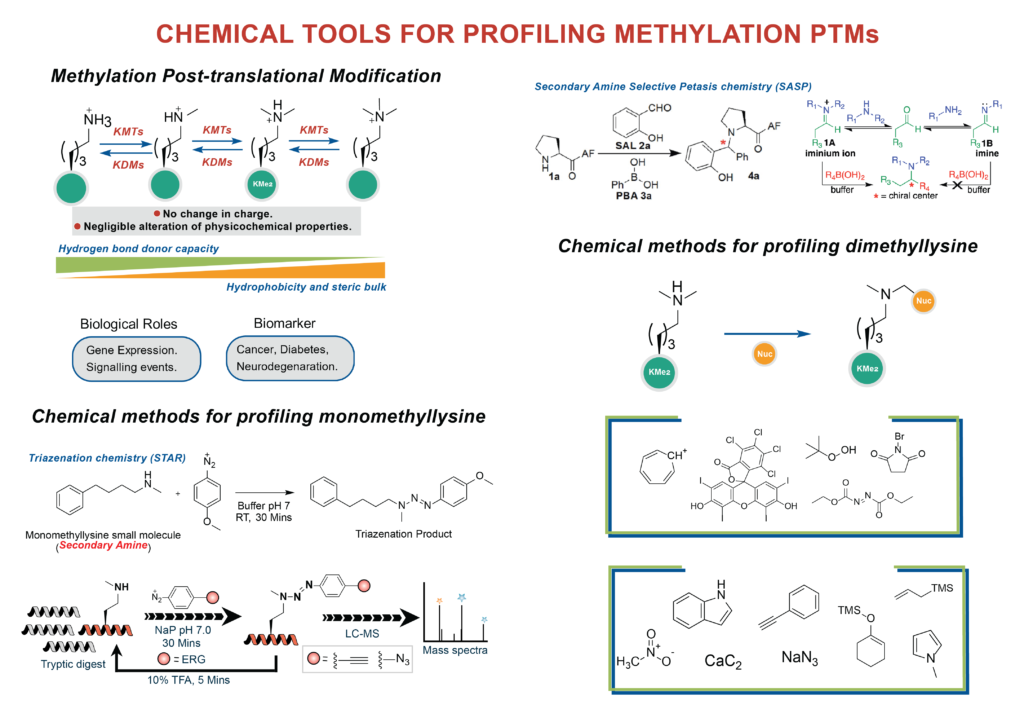Research
In the Raj lab, we develop novel probes, biosensors, molecular imaging agents, and new chemoselective reactions for global profiling of undruggable proteome, selective detection of lysine posttranslational modifications (PTMs), and the synthesis of mechanically interlocked structures, cyclic peptides, and bioconjugates. This research program leads to the discovery of novel protein biomarkers, enzyme inhibitors, affordable diagnostic tools for early detection of cancer, and endogenous protein partners thus facilitating the synthesis of biotherapeutics. We utilize organic chemistry tools, biochemical techniques, and structural characterization.
Project
Peptide therapeutics have become increasingly popular in the 21st century, though they are plagued by two major problems: limitation in high throughput screening, and an inability to accurately predict their cell permeability. These two limitations have been a major obstacle in developing new peptide therapeutics.
We have recently developed a novel “CyClick” strategy for the cyclization of peptides that works in an exclusively intramolecular fashion thereby precluding the formation of dimers and oligomers via intermolecular reactions. The CyClick chemistry is highly chemoselective for the N-terminus of the peptide with a C-terminal aldehyde. In preliminary work, we have utilized this method for synthesis of various macrocycles of different ring sizes 12- to 24-membered rings with varying amino acid compositions, under mild reaction conditions. We seek to use the power of the “CyClick” strategy to synthesize libraries of cyclic peptides with photoaffinity tag in one pot followed by their incubation with cell lysate to discover new inhibitors of various protein targets.
Additionally, we have recently begun combining computational approaches and artificial intelligence with experimental data in an effort to predict the permeability of peptides.
Selection of Recent Papers
- Bruce, A.*; Adebomi, V.*; Czabala, P.; Palmer, J.; McFadden, W. M.; Lorson, Z. C.; Slack, R. L.; Bhardway, G.; Sarafianos, S. G.; Raj, M. A Tag-Free Platform for Synthesis and Screening of Cyclic Peptide Libraries. Angew. Chem., Int. Ed. 2024, 63, e202320045.
- Shao, H.; Adebomi, V.; Bruce, A.; Raj, M.; Houk, K. N. Intramolecular Hydrogen Bonding Enables a Zwitterionic Mechanism for Macrocyclic Peptide Formation: Computational Mechanistic Studies of CyClick Chemistry. Angew. Chem., Int. Ed. 2023, e202307210.
Project
We are interested in developing novel methods for modifying peptides in a chemoselective manner. This allows for development of new chemical motifs on peptide structures with various physical properties including organelle targeting, fluorescence, and improved cytotoxicty.
Selection of Recent Papers
- Villalobos Galindo, A.; Raj, M. Solvent-Dependent Chemoselectivity Switch to Arg-Lys Imidazole Cross-Links. Org. Lett. 2024, 26, 8356.
- Emenike, B.*; Shahin, S.*; Raj, M. Bioinspired Synthesis of Allysine for Late-Stage Functionalization of Peptides. Angew. Chem., Int. Ed. 2024 e202403215.
- Prosser, L. P.*; Talbott, J. M.*; Garrity, R. P.; Raj, M. C-Terminal Arginine-Selective Cleavage of Peptides as a method for Mimicking Carboxypeptidase B. Org. Lett. 2023, 25, 6206-6210.
Project
Post-Translational Modifications (PTMs) are modifications of amino acids including phosphorylation, acetylation, methylation, and many more. Currently, the dysregulation of PTMs leads to various disease states. However, it is difficult to locate these PTMs in complex biological systems like a proteome, due to their low abundance and lack of specific chemical methods to target each unique PTM
Our lab has previously developed methods for lysine mono-methylation, lysine di-methylation, and histidine methylation. Furthermore, we have developed bioconjugation techniques for Arginine and Methionine. We utilize these chemical methods on cells and mice models to discover new links between unknown proteins and PTMs and disease states.

Selection of Recent Papers
- Paikin, Z. E.*; Emenike, B.*; Shirke, R.; Beusch, C. M.; Gordon, D. E.; Raj, M. Acrolein-Mediated Conversion of Lysine to Electrophilic Heterocycles for Protein Diversification and Toxicity Profiling. J. Am. Chem. Soc. 2025, 147, 5679.
- Sahu, S.*; Emenike, B.*; Buesch, C. M.; Bagchi, P.; Gordon, D. E.; Raj, M. Copper(I)-nitrene platform for chemoproteomic profiling of methionine. Nat. Commun. 2024, 15, 4243.
- Emenike, B.; Czabala, P.; Farhi, J.; Swaminathan, J.; Anslyn, E. V.; Spangle, J.; Raj, M. Tertiary Amine Coupling by Oxidation for Selective Labelling of Dimethyl Lysine Post-Translational Modifications. J. Am. Chem. Soc. 2024, 146, 10621-10631.
Project
Aldehydes are classified as cytotoxic because they damage DNA and proteins by forming interstrand cross-link in human cells. The human body tightly regulates the concentration of aldehydes by aldehyde dehydrogenases that convert toxic aldehydes to nontoxic acids. The mutation in the enzyme ALDH2*2 (present in approximately ~ 0.6 billion people worldwide) leads to accumulation of toxic aldehydes thus contribute to a variety of human diseases including cardiovascular diseases, diabetes, neurodegenerative diseases, stroke, and cancer. Despite the cytotoxicity associated with aldehydes, there are no pharmaceuticals available to eradicate these molecules. This is largely due to the lack of methods to measure the levels of multiple alkyl aldehydes in cells. The main goal of this research proposal is to fill the present gap in the range of available techniques to measure aldehyde levels in cells and the development of new therapeutics. We seek to develop a new family of chemical sensors to measure the total aldehyde levels inside the cell and the concentrations of individual aldehydes. Furthermore, we have begun applying our sensors into mice models to visualize aldehydes in relation to neurodegenerative diseases
Selection of Recent Papers
- Wills, R.*; Shirke, R.*; Hrncir, H.; Talbott, J. M.; Sad, K.; Spangle, J. M.; Gracz, A. D.; Raj, M. Tunable fluorescent probes for detecting aldehydes in living systems. Chem. Sci. 2024, 15, 4673-4769.
- Wills, R.; Farhi, J.; Czabala, P.; Shahin, S.; Spangle, J. M.; Raj, M. Chemical sensors for imaging total cellular aliphatic aldehydes in live cells. Chem. Sci. 2023, 14, 8305-8314.